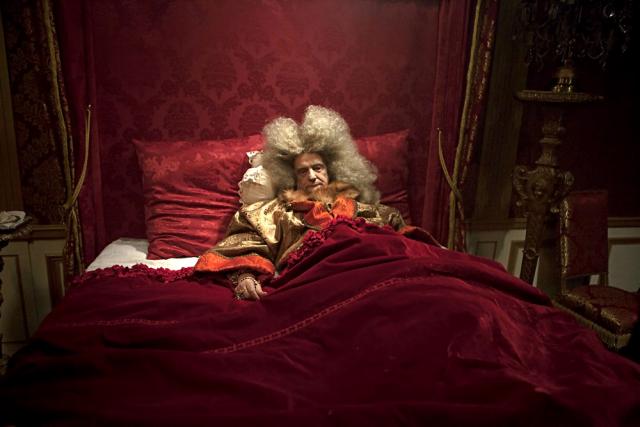by Bill Curran
Laying in regal and rotting repose, the glorious tendrils of a white M-shaped wig framing his ashen face, King Louis XIV of France, in the year 1717, spends his final days dying atop luxurious satins and attended to by hand-wringing bureaucrats and a largely silent wife in Albert Serra’s (you guessed it) The Death of Louis XIV.

As far as “death trip” movies go, Louis XIV is a quintessential ordeal. Like moths around the flame, the films in this still-thriving trend announce the demise (or prolonged distress) of their subjects up front, with imminence and duration the focus, often with a titular clue to the narrative framework: The Passion of the Christ, Last Days, 12 Years a Slave, The Death of Mr. Lazarescu, 4 Months, 3 Weeks, and 2 Days, 127 Hours, Day Night Day Night, Hunger, Two Days, One Night, and Son of Saul, to name but a few...
As an arthouse corrective to Hollywood’s disaster flicks, these films explicitly tie the characters’ trials of mind, body, and spirit to audience stamina and an ever-present sense of dread. (For the original, fuller analysis of this trend, check out J. Hoberman’s book Film After Film.) With Louis XIV, Albert Serra, the young, eccentric director of The Story of My Death (these titles!), adds his own entry to the growing list, and one with a peculiar cinematic twist.

Claustrophobic by design, Louis XIV provides only two brief glimpses of the outside world, the most potent being a prologue featuring Louis wheeled around the grounds of Versailles at twilight. Otherwise, we languish in the royal bedchamber. At first Louis, old and sick but still majestic, attempts a courtly routine of evening soirees, guests now gathering at his bedside with candelabras and party masks in tow. He indulges them with a senile tip of his cavalier hat, to hearty applause. There are trips to policy meetings, comical from all perspectives—Louis’s, his council’s, and the audience’s—with the Sun King’s demented, non-sequitur pronouncements. All the while, his advisors anguish over the status of the King’s limp leg… which turns out to be a gnarly case of unattended gangrene. They talk amongst themselves, and often in front of Louis, paralyzed by their duty to attend to both the whims of King and the needs of country.
Inaction settles in, desperation follows. A medicine man carrying a bull semen potion weasels his way into Louis’ (final) resting place, given carte blanche to cure the blackening limb while the era’s most sophisticated modern doctors from the Sorbonne look on dismayed and forlorn. Family, in the meantime, has drifted out of sight. (They will only be called back into the room to weep ceremoniously over Louis’ corpse.) The variations of light in the room—and, by extension, the perception of time—tighten to a needlepoint: we enter a perpetual midnight chiaroscuro, deep and serious and befitting a King’s dying days. As the end nears, the camera turns its ever-attentive gaze on Louis’ inability to sip wine, then water. Last rites are performed twice. And after his death, there are still official tasks to perform. The sun may set on Louis, but not the French empire.
 The 400 Blows (1959)
The 400 Blows (1959)
To all this deathly foreboding, Serra adds one more layer of cinephilic sadomasochism, because Louis XIV is embodied by Jean-Pierre Léaud. Serra knows his potential audience (and the limits of his potential international distribution) almost too well: for those to whom this means anything, it is a grand, sad bow to the end of an era in French cinema, glimpsed in the aging face of an iconic rapscallion, best known for a freeze frame on his boyhood face in Francois Truffaut’s The 400 Blows. But to all others, the film begs for clarification: where is the drama and why the ordeal?
In truth, The Death of Louis XIV is more fun to write about and ruminate over than to watch: once one gets past the French cinema metaphor, there’s not much here to sustain two hours, and Serra is content to coast on these movie-movie shadings as a means to add depth and breathing room to his hermetic creation. It is a credit to Leaud’s very game performance that, in the end, we’ve cared more about the mask (Léaud) than the man (Louis).
The Death of Louis XIV opens Friday in limited release